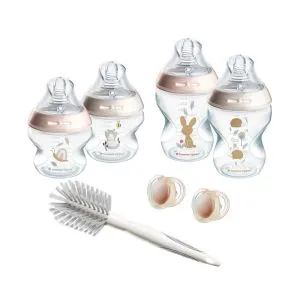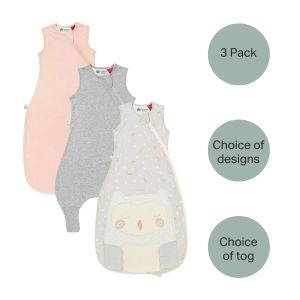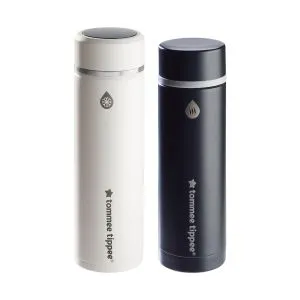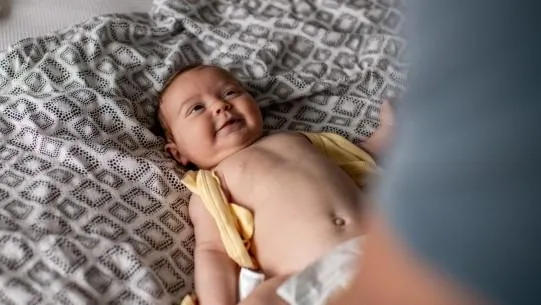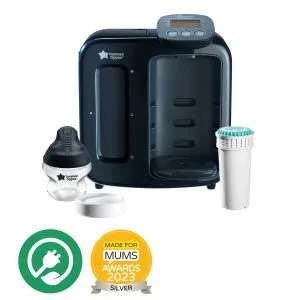
Tommee Tipps
Nappy rash… it’s sore, it’s red and it’s uncomfy for your little one. But it’s also pretty easy to treat and maybe not as scary as you think it is.
The Causes and Solutions for Nappy Rash
Nappy rash… it’s sore, it’s red and it’s uncomfortable for your little one.
But parents should never feel guilty if their baby does get nappy rash. It’s just part of having a baby. And although it’s more common in bigger babies and toddlers than it is in newborns, the majority of babies will experience nappy rash at least once in the first two years of their life. In fact, one in four babies have nappy rash at any time, according to the NHS.
We’re here to talk you through what nappy rash is, what causes it and how to treat it. Let’s get into it.
What is nappy rash?
By definition, nappy rash is an acute inflammatory reaction of the skin in the nappy area.
What are the symptoms of nappy rash?
If a little one has nappy rash, they may appear distressed, agitated, or uncomfortable, as the rash may be itchy and painful. The rash will be visible and show as patches of inflamed skin on your baby’s bottom.
In severe cases, there might be small specks of blood in their nappy, from irritated skin. You might also notice that your little one is fussy or seems irritated, especially when they’re having a wee or a poo, or when you’re changing their nappy. In other cases, they might not seem bothered at all!
What does nappy rash look like?
It’s good to know exactly what you’re looking for when it comes to nappy rash. The rash itself can range from a mild to a large rash that can spread across a baby’s bottom and thighs.
The skin around their nappy area may be…
- red or inflamed
- spotty or bumpy
- hot to touch
- blistered
The different types of nappy rash
If you’re looking to get scientific, there are a bunch of different types of nappy rash that your baby could get – some more common than others:
-
Irritant dermatitis
The most common type of nappy rash, irritant dermatitis is caused by a wet nappy being in contact with your baby's skin. To avoid this, you should change your baby's nappy regularly and use a solid nappy cream.
-
Candidiasis (yeast infection)
Yeast overgrowth in the nappy region is often caused by diarrhoea or tight nappies. A good nappy cream should be able to tackle this, but if not, you can always visit your doctor.
-
Bacterial infections
This infection is often caused when a baby's skin is already irritated, and bacteria builds in irritated areas. Antibiotics are normally needed for a bacterial infection. So, if you notice puss-filled blisters or hard scabs around their nappy area, you should consult your doctor.
What causes nappy rash?
Nappy rash is commonly caused by an irritant contact dermatitis, but there are also some other common causes to look out for. These can include:
- Their nappy isn’t being changed often enough and their skin is becoming irritated by the moisture. Your baby has super sensitive skin which doesn’t like to be wet or irritated. Unfortunately, your baby also likes to wee and poo in their nappy, and even the most absorbent nappy will still leave some moisture on your baby’s skin.
- Their nappy may be too tight and is rubbing on their skin.
- The skin in their nappy area hasn’t been cleaned thoroughly enough during changes.
- Their skin could be reacting to irritants in soaps, wipes, or detergent.
- Diarrhoea is causing extra moisture to build up in their nappy.
- Your baby has recently been treated with antibiotics.
How to help nappy rash
While nappy rash can be unpleasant for everyone involved, there’re some simple steps that parents can take to prevent and treat it.
Preventing nappy rash
The best way to deal with nappy rash is to try and avoid it in the first place. Here are some of the best methods of avoiding nappy rash:
-
Change your baby’s nappy often
It’s best to change your baby’s nappy right away as soon as you notice it’s wet or dirty. When you do change your baby’s nappy, be sure to use baby wipes that are free from fragrance or alcohol.
-
Clean your baby once a day
You should wash your baby enough to keep them clean and their skin hydrated but not too much to dry out their skin.
-
Avoid soap and bubble bath
When cleaning your baby, it’s best to avoid using soap or bubble bath, as these can cause extra irritation.
-
Keep your baby’s nappy area dry
It’s important to dry your baby gently after washing them by patting – not rubbing – their skin. Also, try to avoid talcum powder, as it could irritate their delicate skin.
-
Choose the right size nappy
It’s important to make sure your baby’s nappy fits correctly. It should be snug under the belly button and the tape should be fastened evenly.
-
Have some nappy-free time
Especially after a bath, you might want to pop your baby on a towel and let them wriggle around in the nude for a while before putting them in a fresh nappy.
-
Wash your hands
Anyone who changes your baby should make sure that they clean their hands thoroughly before and after every change.
Treating nappy rash
Sometimes you take all the precautions in the world and can still be stuck with a little nappy rash – it happens. But don’t worry because you can almost always treat nappy rash at home.
The best thing to do is keep their nappy area clean and dry and invest in a top-notch barrier cream or ointment. Many parents swear by Sudocrem. It’s a great all-round soother and healer for your little one’s sensitive skin, as well as containing antiseptic and antibacterial properties to fight off further infections.
If you think your baby’s rash might be an allergic reaction, try to figure out if you’ve introduced any new foods or used any new products recently. The culprit is often detergent or soap!
If your baby’s nappy rash gets worse, even after several days of home treatments, is severe or occurs along with a fever, you should seek advice from your family doctor or a pharmacist to ensure that the rash isn’t infected. They’ll be able to prescribe you some medication to help soothe and treat the rash.
Nappy rash FAQs
-
Does Vaseline® help nappy rash?
Yes, according to the brand’s website, Vaseline® Jelly can be applied to form a protective barrier after wiping your child’s bottom clean. It can also help prevent irritants from making sore skin from nappy rash feel worse, while also locking in moisture to calm and soothe your baby’s skin.
-
How long does nappy rash last?
If you follow the points and guidance above, nappy rash should usually clear up after about three days. If it persists for longer, you should always speak to your health visitor, a pharmacist, or your family doctor and ask for their advice.
-
Do babies get nappy rash when teething?
Nappy rash and teething are not usually linked, although they may happen at the same time. Fever and other symptoms like diarrhoea, rashes (other than those on the face), and vomiting are very unlikely to be caused by teething. A baby experiencing these should be taken to see a doctor as soon as possible.
-
How do you apply nappy rash cream?
Once your baby’s bottom is clean and dry, you can apply a thin layer of nappy rash cream to both their bottom and the folds in their skin after each nappy change, especially before bedtime and after any nighttime changes. Before you apply the cream, always read the instructions for the specific cream you're using. Then, place a clean nappy beneath your baby, ready to put on, and apply a button-sized amount to their bottom using a gentle touch. A little goes a long way!


